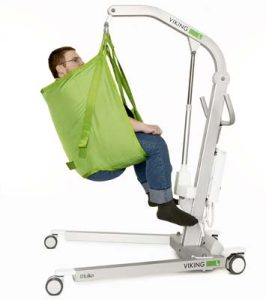Dropped During Transfer
 The nursing assistants dropped during transfer a demented patient. They used a hydraulic lift while getting her into a wheelchair. There was a sickening thud as a patient hit the floor. Afraid they would lose their jobs, the aides did not report the incident. The next day, the patient had bruises. The daughter came into visit her mother and demanded an explanation.
The nursing assistants dropped during transfer a demented patient. They used a hydraulic lift while getting her into a wheelchair. There was a sickening thud as a patient hit the floor. Afraid they would lose their jobs, the aides did not report the incident. The next day, the patient had bruises. The daughter came into visit her mother and demanded an explanation.
No one knew what happened. No one talked. No one confessed. The daughter thought her mother was assaulted and notified the police. The police could not determine what happened. The daughter asked for a copy of the medical record. It did not explain what happened. Her mother’s condition worsened and she died of a head injury. Frustrated by the lack of information and grieving over her loss, the daughter sought a plaintiff attorney’s help.
LNC role helping attorney with a case of dropped during transfer
This is an all too common scenario in our legal nurse consulting business. We’ve handled several cases like this. What do you need to know to help an attorney with this type of case?
What are the damages?
A drop during transfer may result in fractured extremities, spinal cord injury, head trauma, and soft tissue injuries. Damages are compounded if the patient is receiving Heparin, Coumadin, Lovenox and other anticoagulants.
Is there causation?
Can the injuries be tied to an incident? Is there any other plausible explanation for the injuries the patient suffered?
What is the liability?
Staff are expected, according to the standard of care, to use the appropriate number of people and equipment needed to safely move a patient. A dropped during transfer incident can occur under the following circumstances:
- The nurse rolls the patient over in bed without putting up the side rail.
- The patient is rolled off a stretcher. (These types of incidents are rare. It is more common for the patient to be dropped during a transfer from a bed to a chair or chair to wheelchair.)
- The patient may fall if caregivers neglect to assess her handling requirements and or overestimate their own physical abilities.
Was there a cover up?
Delay in recognition of the injury worsens the problem. Instead of properly assessing the pain in terms of onset, associated symptoms, radiation, or ability to bear weight, the staff may medicate the patient with an analgesic.
Since the aides did not report the incident, the physical therapy and nursing staff continue to handle the patient, increasing her pain and risk of additional injury. The delay in reporting the dropped during transfer incident may lead to worsening head trauma, and irreversible increased cerebral pressure.
Standard of care for prevention of drops
Here is what you should expect to see in the way of safety precautions. The staff should:
- Offer assistance to frail people who are at risk for falls.
- Keep side rails up when turning patients or while they are sedated.
- Obtain help to move a patient when there is a risk of the patient being uncooperative, too heavy to manage or too frail
- Make sure there are two people involved in a transfer with a hydraulic lift – three including the patient. One person moves the lift and one person guides the patient’s body.
- Participate in periodic inservices on safe patient handling techniques.
- Perform accurate fall risk assessments according to policy.
- Examine the patient care environment for assistive devices that improve mobility and safety, such as grab bars, hand rails, raised toilet seats, lockable wheelchairs, good lighting, low bed heights, and other safety devices.
- Review the fall alert program to determine if it specifically advises staff and visitors of the patient’s risk for falls.
- Ensure there is a comprehensive clinical and risk evaluation after a fall.
- Ensure that falls are tracked through the quality improvement program, and opportunities for improvement are identified and addressed.
You may help your attorney client by preparing questions to ask of the defendants. Use the points above to get a head start.
